
|

|
|
Home Site Search Contact Us Subscribe
|
|
New York Falls in Love with Gaudí's Complexity A school of architecture displays the Sagrada Familia as a collective masterwork. By Vicente Jiménez, El País; translated by Prof. Lisa Paravisini-Gebert October 31, 2014 Editor’s note: This article first appeared in the October 20, 2014 issue of El País with the title “Nueva York se enamora de la complejidad de Gaudí” (link to original). It has been translated and re-published here with permission (our thanks to George Ranalli and his colleagues for making this possible).
The only previous exhibit of the materials in “Sagrada Família - Gaudí's Unfinished Masterpiece” has been at the Vatican Museum in Rome. This exhibition is the fist and only time the materials have ever been released by the church, and will be on view at CCNY Bernard and Anne Spitzer School of Architecture, New York City, through May 15, 2015. See a short video introduction here.
Julio Salcedo’s smile has a special character today. As a professor at the Bernard and Anne Spitzer School of Architecture at the City College of New York, it is not every day that he has the opportunity to bring before his students the genius of a fellow countryman, even one who died under the wheels of a streetcar in Barcelona 88 years ago. These days, the prestigious New York institution is hosting a very special exhibit and series of lectures, Sagrada Família - Gaudí's Unfinished Masterpiece: Geometry, Construction and Site, the first ever in the United States, according to architect George Ranalli, its curator. “What a wonderful way to start the fall season,” proclaimed City College President Lisa S. Coico, during the opening ceremony.
“This school understands architecture as a civic and urban process, and that is precisely what Gaudí’s architecture is. His work is complex and that is a style we appreciate here. We don’t understand architecture as something formal, guided by fashion, but as a social phenomenon. This is why Gaudí is here now,” a proud Salcedo declares, as his students stare delightedly at the maquettes, photos, blueprints, and other materials about the Barcelona cathedral.
Sunny Fok, a graduating student, is among them. “It is impressive, overwhelming. The feeling for nature is marvelous, the colors ... I spent a month in Barcelona last year admiring Gaudí’s work. It was a fantastic experience,” he explains under the interested gaze of his friend Katrina Durán, a recent arrival to the school. “I have not been able to go to Barcelona yet, but I am longing to go. It’s very moving to see what Gaudí accomplished so many years ago,” Katrina comments.
Billy Schaefer, one of the school’s most talented students, remembers his experiences as a child in the Catalan capital: “I visited when I was ten years old and I remember those incredible structures. Gaudí is a favorite with children. His work is ludic. His structures, the curving lines of Parc Güell, are like playgrounds.” Schaefer is no longer a child. He sees the master now through a different set of eyes. “It is interesting for a city like New York to see the work of a genius like Gaudí. Here we have a proliferation of styles, from the most rational to the most creative. Gaudí offers a link to the past but always looking towards the future, because he was a pioneer”.
Salcedo concurs with his student’s reflection: “Our school looks carefully at that link between the past and the future. Gaudí represents innovation, but also historicism, a past that can be traced back, even to Africa. All that amalgam, that complexity, is a part of this school. The idea behind this exhibit is for students to dig deep, to get them to know the genre, to see that everything they’ve been told is true. It is about entering a geometric, social, and cultural universe.”
The exhibit is organized in five categories or panels, Argentinean architect and assistant curator Fabián Llonch explains. The first is dedicated to the figure of Gaudí, his character and transcendence. The second, to the building, to the Sagrada Familia and its relationship to the city of Barcelona. The Catalan genius’s complex geometry occupies the third space. The last two spaces focus on the actual construction and the nearly-completed work.
The exhibit, which can be visited until May 15, 2015, and is sponsored by Banco Santander, offers an opportunity to reclaim the generosity of a unique creator. Ranalli remembered the words of the Catalan master (“Great temples are not the work of one sole architect. I know that the personal tastes of those who will succeed me will influence the final work, but this does not matter to me. It will all be to the benefit of the work. A work like this should be the offspring of a long era. The longer the better”) to underscore the value of teamwork: “The Sagrada Familia is impregnated by Gaudí’s work, but the project has been evolving well through many innovative contributions from others. Gaudí’s work is linked in an exquisite way to more recent contributions. Undoubtedly, the success of the Sagrada Familia argues against the notion of single authorship as an architectonic ideal.”
For Ranalli, “Gaudí is foundation, culture, a symbol of creation, and that is what Sagrada Familia is to an astounding level.” But it’s not just that. The veteran architect considers that the way in which the master links his work to its environment is an example for new generations of professionals. “The exhibit demonstrates how an architectonic icon can become an integral part of its environment. The general answer in our times has been “oppositionalism,” which has generated environments that are not well integrated. I hope this exhibit encourages students to consider carefully the neighboring work when they engage their projects.”
For this reason, during the months of October and November, professionals linked to the construction of the Sagrada Familia will offer a series of lectures at the Bernard and Anne Spitzer School. They are architects Josep Gómez Serrano, Jordi Bonet, Jordi Faulí, Judith Rohrer, Maria Rubert de Ventós, Xisco Llabrés, and Mark Burry.
For George Ranalli, Gaudí’s presence in New York is a vindication of the complexity of a city that is very particular, unique. His colleague Salcedo concurs: “Ranalli is very critical of over-simplified architecture. He defends work that has a sense of mass, of solidity, of detail and complexity. New York City is complex, but nowadays you note that lack of complexity in the architecture. Gaudí is an example for all.” |
(click on pictures to enlarge) 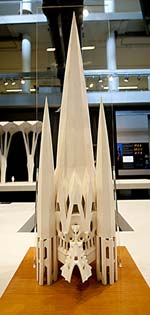 Gordon Gebert Views of “Sagrada Família - Gaudí's Unfinished Masterpiece” at CCNY Bernard and Anne Spitzer School of Architecture, New York City, on view through May 15, 2015 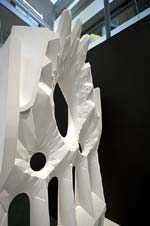 Gordon Gebert
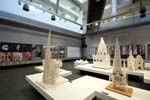 Gordon Gebert
 Gordon Gebert
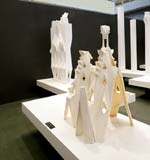 Gordon Gebert
 Gordon Gebert
 Gordon Gebert
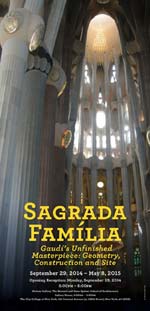 Gordon Gebert
|
© 2014 ArchNewsNow.com